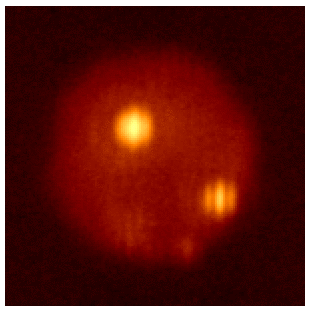

Lava lakes on Earth are vast cauldrons of molten rock that you should definitely not throw your trash into. (PSA: You should also not jump into a lava lake. You would die.)
But as terrifyingly impressive as terrestrial lava lakes are, they have absolutely nothing on Loki Patera. Located on Jupiter’s moon Io, this lava lake is 127 miles across and covers over 8,300 square miles—that’s larger than Lake Ontario.
In a study published Wednesday in Nature, researchers used a giant telescope and the movement of Jupiter’s moons to get the most detailed look ever at this lava lake, taking its temperature from millions of miles away.
Io itself is the most volcanically active entity in the solar system. Its interior is constantly heated by the gravitational pull of Jupiter and its larger moons. This tidal heating keeps the interior melty, and ensures that over large parts of the moon’s crust, the floor is literally lava.
Outpourings of lava onto the surface, from ephemeral eruptions to the more stable lava lakes like Loki Patera, dot Io’s surface with bright spots. By looking at these spots in infrared, researchers can measure how much heat is coming off the volcanic features. In previous studies volcanologists noticed that the temperature of Loki Patera fluctuated, brightening about every 500 days. Now they have a better idea of why, and it’s all thanks to Europa, another moon of Jupiter.
On March 8, 2015, Europa passed between Io and Earth, temporarily blocking infrared light from Loki Patera from reaching our planet in an event called an occultation (very similar to an eclipse). “It’s an elegant planetary ballet choreographed by the laws of physics,” says Ashley Davies, one of the study’s authors.
Because the lake is so large, the researchers using the Large Binocular Telescope were able to isolate and measure the temperature of different parts of the lake as Europa blocked out extraneous light from the surrounding area. They found that the lava was hottest in the southeastern corner of the lake, and cooler to the northwest.
With that information, they were able to pull together an explanation for the strange fluctuations in temperature observed by the Galileo spacecraft and ground-based telescopes. It seems that periodically, the lava at the very top of the lake will form a crust, cool into a dense mass, and then sink, exposing hotter lava as it goes. Using the temperature measurements on Io—and comparing those to cooling rates of lava lakes on Earth—the researchers can figure out not only how hot the lava in Loki Patera is, but how old it is as well.
“If Loki Patera is a sea of lava, it encompasses an area more than a million times that of a typical lava lake on Earth,” lead study author Katherine de Kleer said in a statement. “In this scenario, portions of cool crust sink, exposing the incandescent magma underneath and causing a brightening in the infrared.”

The lava cools in two waves, one that travels counterclockwise from the north of the lake, and one that travels clockwise, both of which start at on opposite sides of an island in the middle.
The waves of activity move across the lake relatively slowly—at a rate of about a kilometer a day—and while they start at roughly the same time, their start times do differ slightly. Davies says this might be because there are two distinct sources of magma feeding each area of the lake, with different compositions or gas content causing the cooled crust to sink at different rates.
The lava lakes on Io are fascinating to volcanologists for a number of reasons. First, their behavior tells us a bit about our own past.
“In Earth’s distant history volcanism was a lot more prevalent that it was today,” Davies says. “Earth, the Moon, Mars, and Venus were all modified by huge eruption events.”
But the detailed measurements also tell us more about tidal heating, the gravity pull that keeps Io so hot. That’s particularly interesting, because similar forces are at work on Io’s neighbors, Ganymede and Europa—which are considered likely candidates in our ongoing search for life.
It’s also just a fascinating topic. The researchers plan to take another peek at the lava lake when Europa occults Io again in 2021.